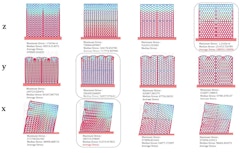
Facade Resilience Evaluation Framework
Resiliency is the capacity of a building (or building component in the case of the facade) to support building functionalities during extreme events

Resiliency is the capacity of a building (or building component in the case of the facade) to support building functionalities during extreme events
The stability of monolithic glass fins is reasonably well defined; as an elastic material it behaves in a similar manner to other elastic materials

Traditional approach for engineering the facade is building an isolated analysis model. However, it inhibits a dynamic design process where

Glass has become a popular building material that is used not only for windows but also as a load-bearing material. New dimensions of glass panes in


This research looks at the relationship of material and geometric distribution to set a methodology for integrating structural and thermal design.

As overall project schedules continue to contract and rising costs impact our design decisions, the importance of the design-assist phase for facades

The SCALP device is designed to measure the residual compressive surface stress of glass. As the SCALP does not rely on the birefringence properties
Other than limited special cases, there is a lack of standards providing guidance on the design of structural glass. This has resulted in an ad-hoc


User centred façades | The Future Envelope 13 – Conference on Building Envelopes | During the 13th edition of the annual conference, twelve international speakers from research, industry, management and design will share their experience and visions of the future building envelope.

Glass is an essential component for any type of building. Its transparency enhances daylighting and provides occupants a view to the outside. Whether

Building envelopes are not only an immediately visible part of the building, they have also become a major factor both for cost and performance of



Effective thickness is a simplified method for the structural evaluation of laminated glass section properties. The method consists of defining the
Embodied carbon in buildings is a key factor in building decarbonization and while it is generally small compared to operational carbon, the
